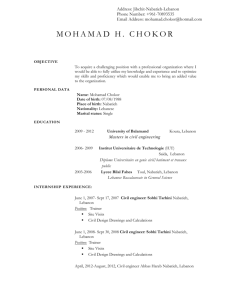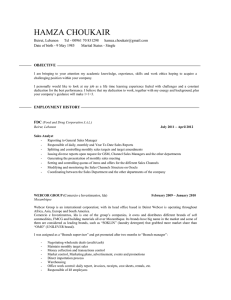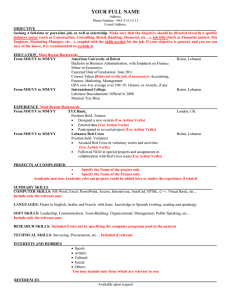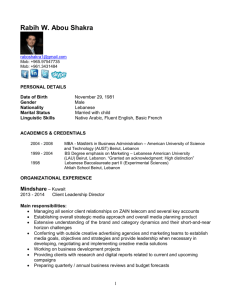Document 17850991
advertisement
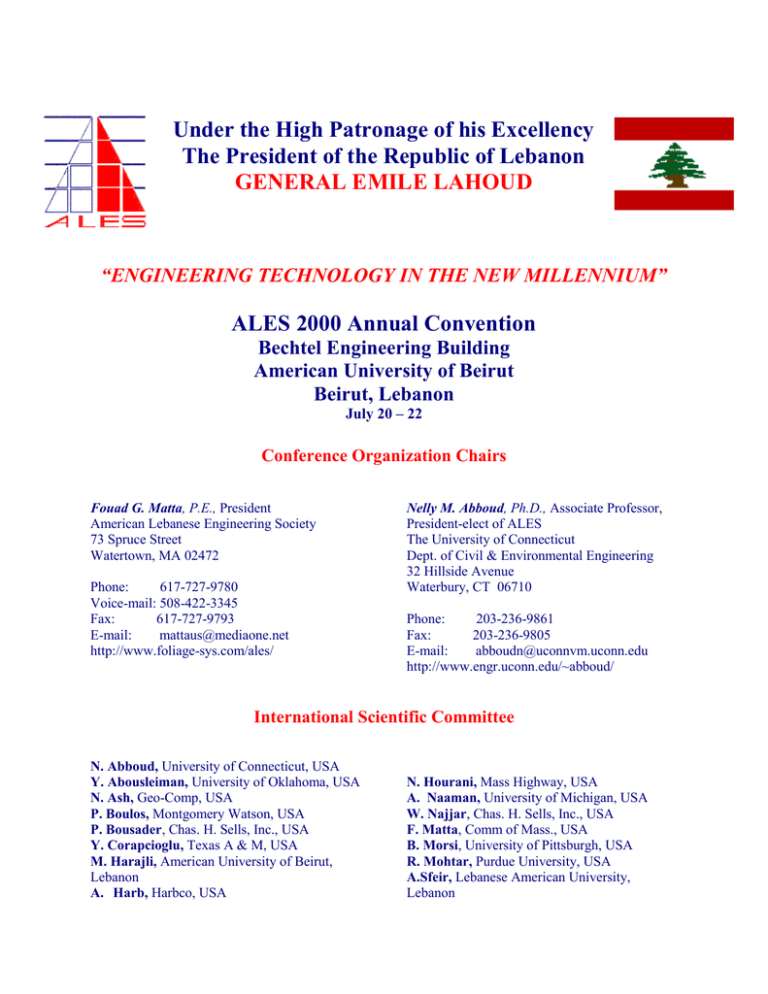
Under the High Patronage of his Excellency The President of the Republic of Lebanon GENERAL EMILE LAHOUD “ENGINEERING TECHNOLOGY IN THE NEW MILLENNIUM” ALES 2000 Annual Convention Bechtel Engineering Building American University of Beirut Beirut, Lebanon July 20 – 22 Conference Organization Chairs Fouad G. Matta, P.E., President American Lebanese Engineering Society 73 Spruce Street Watertown, MA 02472 Phone: 617-727-9780 Voice-mail: 508-422-3345 Fax: 617-727-9793 E-mail: mattaus@mediaone.net http://www.foliage-sys.com/ales/ Nelly M. Abboud, Ph.D., Associate Professor, President-elect of ALES The University of Connecticut Dept. of Civil & Environmental Engineering 32 Hillside Avenue Waterbury, CT 06710 Phone: 203-236-9861 Fax: 203-236-9805 E-mail: abboudn@uconnvm.uconn.edu http://www.engr.uconn.edu/~abboud/ International Scientific Committee N. Abboud, University of Connecticut, USA Y. Abousleiman, University of Oklahoma, USA N. Ash, Geo-Comp, USA P. Boulos, Montgomery Watson, USA P. Bousader, Chas. H. Sells, Inc., USA Y. Corapcioglu, Texas A & M, USA M. Harajli, American University of Beirut, Lebanon A. Harb, Harbco, USA N. Hourani, Mass Highway, USA A. Naaman, University of Michigan, USA W. Najjar, Chas. H. Sells, Inc., USA F. Matta, Comm of Mass., USA B. Morsi, University of Pittsburgh, USA R. Mohtar, Purdue University, USA A.Sfeir, Lebanese American University, Lebanon Introduction Engineering Technology was changing at an accelerated pace in the last decade of the twentieth century. The remarkable advancements in the Information Technology led to innovations and new design methods in all fields of engineering. Also, with the perpetual increase in the world population and with a more rapidly growing demand for engineers, there seems to be a pressing need for repair, rehabilitation, and renovation of existing engineering systems, as well as designing more sophisticated and complex systems to meet the demand in the twenty first century. The Middle East and especially Lebanon are presently in an era of new construction, rehabilitation, and implementation of information technology systems. The selection of Lebanon as the location for the Convention is intended to serve as a large scale interactive workshop, as well as a means for the scientific community to contribute to the peaceful efforts to re-normalize this country after more than sixteen years of civil war. Objective The objective of the Convention is to provide a forum for public administrators, owners, specialists, professionals, and researchers from different parts of the world. These professionals will have the opportunity to discuss practical ideas, share experience, knowledge and vision into the future. They will identify the needs in the twenty first century and how these needs will be met by engineers and scientists collaborating across the borders, in the Middle East region and all over the world. Sponsors American Lebanese Engineering Society, USA American University of Beirut (AUB), Lebanon Harbco, USA Siemon company, USA University of Connecticut, USA Financial Organizers American Lebanese Engineering Society (ALES), USA. Language The official language of the convention will be English. All presentations and discussion will be in English. Local Organizing Committee-Lebanon M. Harajli, American University of Beirut I. Kaysi, American University of Beirut S. Khoury, American University of Beirut M. Najjar, University of Balamand G. Nicolas, Lebanese American University B. Zaouk, Certification Board of Professional Engineers 2 Thursday July 20, 2000 7:30am - 9:00am 9:00am - 10:00am 10:00am - 10:15am 10:15am - 11:00am 11:00am - 11:45am 12:00am - 1:15pm 1:15pm - 2:00pm 2:00pm - 2:45pm 2:45pm - 3:00pm 3:00pm - 3:45pm 3:45pm - 4:30pm 4:30pm -5:15pm 5:30pm - 7:00pm Friday July 21, 2000 Registration Opening- Planetary Keynote Speaker, President Lahoud's Representative, Minister Nagib Mikati, Minister of Public Works, Lebanon BREAK Nabil Hourani, PE, Mass Highway, Massachusetts, USA "Application of Ground Improvement Techniques in the Northeastern United States" Dr. Antoine Hobeika*, Tammam Nakkash, Ph.D., Jamal El-Zarif, and Linda Katran, TEAM Int'l, Lebanon, *Virginia Tech, Virginia, USA "Evaluating Transportation Investments in Beirut, Lebanon" LUNCH Dr. Rabi Mohtar, and M. Benner, Purdue University, IN, USA "Analysis of Air Sparging Systems for Soil and Groundwater Remediation" Dr. Walid Salim Najjar, PE and Philippe Bousader, PE, CHAS. H. SELLS, INC, New York, USA "The Art and Science of Bridge Load Rating" BREAK V. J. Murphy, P.B. Hubbard, E.Rostosky, and Dr. Alfredo Urzua*, Weston Geophysical Corp, *Prototype Engineering, Massachusetts, USA "Non-Destructive (NDT) Verification for Soil-Mix and Concrete" Dr. Yehia Anis Daou, Beirut Arab University, Lebanon "The Adequacy of the Minimum Shear Reinforcement Provision in High Strength Concrete" Dr. Mahmoud Ghazavi, Isfahan University of Technology, Isfahan, IRAN "Vertical Vibration of Deep Foundations in Layered Deposits" ALES BOARD MEETING 7:30am - 8:30am 8:30am - 9:15am 9:15am - 10:00am 10:00am - 10:15am 10:15am - 11:00am 11:00am - 11:45am 12:00am - 1:15pm 1:15pm - 2:00pm 2:00pm - 2:45pm 2:45pm - 3:00pm 3:00pm - 3:20pm 3:20pm - 3:45pm 3:45pm - 4:30pm 7:00pm - 3 Registration Keynote Speaker: Dr. Osman Shinaishin, Senior Program Manager North Africa, Near East and South Asia, National Science Foundation, Virginia, USA Dr. A. Al-Hajj, Dr. A.Whyte, and Dr. G. Aouad, The Robert Gordon University, Aberdeen, UK "The Development of the Framework for Life Cycle Costing for Integration at the Design Phase for Use in Object Oriented and VR Technologies" BREAK Dr. Abdallah. Sfeir, Lebanese American University, Lebanon "Computer Algebra in Engineering Concepts and Methods" Dr. Milad A. Shaheen, Kaiser Electroprecision, California, USA "Computer Aided Design (CAD) and Computer Aided Engineering (CAE) in the New Millennium" LUNCH Dr. Paul Boulos, Zheng.Y. Wu, J.Erick Health, and Paul M. Hauffen, MW Soft Inc., California, USA "Optimal Design and Rehabilitation of Water Distribution Piping Systems" Dr. Dada Najjar Jabbour, Dept. of Public Health, City of Waterbury, Connecticut, USA "Municipal Management of Environmental Issues" BREAK Dr. Nelly M. Abboud, and Philippe Bousader, PE, University of Connecticut, Connecticut, USA "Recycled Wastewater and its Positive Impact on the Environment in Lebanon" Rana Louis Kobrossi, American University of Beirut, LEBANON "Health Effects of Air Pollution in the Regions of Koura, Batroun and Jbeil in Lebanon" Philippe Bousader, PE and Dr. Walid Salim Najjar, PE, CHAS. H. SELLS, INC, New York, USA "Retrofitting Old Bridge Structures to Meet Current Standards" DINNER BANQUET / AWARDS Saturday July 22, 2000 9:00am - 11:45am This workshop will provide the opportunity to learn more about recent advances in reliability analysis and computer analysis in geotechnical engineering. The workshop will cover the following: Basic introduction to the use of computers in Geotechnical engineering. (1/2 hour). 1-D Dynamic amplification/soil response. Determination of soil properties, empirical correlation, non-linear effects. Hands on with the computer program UFSHAKE. Examples for typical soil profiles, different ground motions, etc. (2 hours) Development of site specific response spectra. Example of bridge structure. (1 hour). Level ground liquefaction assessment. Equations, theory, computer program LIQFAC, and how to combine it with UFSHAKE for better analysis. Example problems and some ideas about remediation. (1 1/2 hours). Interactive Workshops Dr. Paul F. Boulos, MW Soft Inc., California, USA President and Chief of operating Officer "How to Apply Genetic Algorithm Technology to Optimize Water Distribution Systems" This workshop will provide the opportunity to learn more about the recent advances in genetic algorithm technology and its direct applications to water distribution system optimization. Applications and case studies will be presented using the H2ONET Utility Suite software package, an extended version of the EPANET water distribution modeling software. The applications will demonstrate the efficacy, flexibility, and versatility of genetic algorithm technology to effectively solve a wide range of reallife network modeling problems including: Network model calibration Network rehabilitation Network design and expansion Pump scheduling Dr. Urzua received his MS and Ph.D. from MIT. He is a civil engineer specializing in Geomechanics, Geotechnical, Earthquake Engineering, Reliability Analyses and Computer Applications in Engineering. He is proficient in the application of Finite Element and Finite Difference methods for dynamic soil response, groundwater modeling flow, seepage analysis, and soil structure interaction. Recent experience includes developing and implementing a GIS system for the organization of subsurface data for a major highway department, installation and management of geotechnical and strong motion instrumentation for dams, slopes and other constructed facilities, seismic analysis and dynamic soil response for bridges and dams; seismic hazard assessments; regional groundwater modeling and development of flow nets and seepage patterns; developing computer aided design procedures for liquefaction evaluation, and geotechnical productivity tools for major government agencies. He has been an invited lecturer and provided short courses at several national and international conferences which include MIT, RPI, U.S. Corps of Engineers, Boston Society of Civil Engineers, Naval Facilities Command, Bureau of Reclamation, Colombia, Ecuador, Chile, Mexico, Dominican Republic, Venezuela, Taiwan and Jordan. Dr. Urzua is the co-author of the book Productivity Tools for Geotechnical Engineers, Vol.I. You will have this workshop with the knowledge to apply Genetic Algorithm technology to other areas of distribution management including: Leakage minimization Identifying locations for water quality sampling and booster chlorination stations Improving hydraulic network redundancy Dr. Boulos has written over 100 technical papers and engineering reports and has contributed to the development and enhancement to several widely used computer software packages for water distribution modeling including KYPIPED, EPANET and H2ONET. He is a world expert in water distribution engineering and has won many prestigious honors including technical awards from the American Society of Civil Engineers and the US Environmental Protection Agency. 1:15pm - 5:00pm Dr. Alfredo Urzua, Prototype Engineering Inc., Mass (USA) "Reliability Analyses and Computer Applications in Geotechnical Engineering" 4 APPLICATION OF GROUND IMPROVEMENT TECHNIQUES IN THE NORTHEASTERN UNITED STATES Nabil Hourani, P.E. – Geotechnical Engineer – MassHighway, 10 Park Plaza – Boston, MA 02116, USA ABSTRACT Due to urban expansion, infrastructure development, and building construction on abandoned and difficult sites, there is an increase need and use of various methods and techniques for soil remediation and ground improvement. This Geotechnical Engineering field addresses the issues of soil and rock stabilization, excavation support, and the improvement of properties and performance of foundation materials. This paper will present some of these techniques which have been implemented on various projects within the Northeastern United States. These design concepts and construction methods will be clearly described and lively illustrated. In particular, the presentation will cover Deep Soil Mixing (DSM), Grouting, Soil Nailing, Mechanically Stabilized Earth Walls (MSEW), and foundation improvement for highway embankments using Geosynthetics. Relevant case studies are presented and discussed, for example, a widening of a roadway over unsuitable soils, a retaining structure at a bridge river crossing, a soil nail wall along a scenic mountain road, grouting and soil mixing for an urban underground project. These ground improvement techniques can be applied to development projects in Lebanon and the Middle East where steep hills, unstable rocks, and weak soils exist. These methods are feasible and cost-effective solutions for the problems of unsuitable foundation, seismic prone sites, and congested urban areas. 5 RETROFITTING OLD BRIDGE STRUCTURESTO MEET CURRENT STANDARDS Philippe Bousader, P.E. and Walid Salim Najjar, Ph.D., P.E., CHAS. H. SELLS, INC., Consulting Engineers, 555 Pleasantville Road, South Building, Briarcliff Manor, New York 10510, U.S.A. Tel: 914-747-1120 / Fax: 914-747-1956 / www.chashsells.com ABSTRACT: A challenge faced by many bridge owners and governmental agencies is to evaluate bridge rehabilitation alternatives, including replacement, and to select the most cost efficient alternative. This paper presents a feasible method for retrofitting an existing bridge to meet current design standards. The subject structure is a 75 years old steel viaduct in need for rehabilitation. The proposed construction work involves replacement of a deteriorated deck, elimination of two non-redundant thru-girders and upgrading all structural elements to meet seismic requirements. The upgraded structure consists of new multi-girders with an Exodermic deck system lighter than conventional cast-in-place concrete; seismic isolation bearings are used to satisfy seismic criteria. The design is performed in accordance with the AASHTO methods of Load and Resistance Factor Design, and Seismic Isolation Design. Key Words: Bridge rehabilitation, structural redundancy, Exodermic deck, isolation bearings, LRFD design, steel construction. 6 THE ART AND SCIENCE OF BRIDGE LOAD RATING Walid Salim Najjar, Ph.D., P.E. and Philippe Bousader, P.E., CHAS. H. SELLS, INC., Consulting Engineers, 555 Pleasantville Road, South Building, Briarcliff Manor, New York 10510, U.S.A. Tel: 914-747-1120 / Fax: 914-747-1956 / www.chashsells.com ABSTRACT Load rating is an evaluation of the safe capacity and fatigue life of a bridge structure to support heavy moving loads such as highway trucks or railway trains. With aging bridges worldwide, increasing load requirements and financial demands, load rating is essential for sustaining old and historic bridges in the new millennium. The evaluation is based on inspected bridge conditions, as supplemented by design and construction records, and is guided by established design methods and specifications. Rating calculations are first performed with simplifying conservative assumptions, in order to satisfy project-time constraints. However, if the results are below the expectations or needs of a bridge Owner, then advanced analyses are necessary for determining a more precise rating. Engineering judgements are often required in making the assumptions, because of insufficient information on existing conditions or variances in interpreting available information. Also, specifications are subject to misinterpretations, since they are written for designing new bridges and are not intended for rating old ones. Indeed there is art in the science and technology of bridge load rating, as demonstrated through case investigations in this article presentation. Key Words: Load rating, highway bridge, railway bridge, inspection, structural evaluation. 7 NON-DESTRUCTIVE (NDT) VERIFICATION FOR SOIL-MIX AND CONCRETE V. J. Murphy, P. B. Hubbard, E. Rostosky, Weston Geophysical *, and A. Urzua, Prototype Engineering, Inc. *, Weston Geophysical Corp., 325 West Main St, Northboro, MA 01532 Email: vmurphy@weston-geo.com, * Prototype Eng. Inc., 57 Westland Av., Winchester, MA 01890, e-mail: urzua@bc.edu ABSTRACT Soft soils mixed with cement, as well as concrete for structures, must attain unconfined compressive strengths (UCCS) that satisfy design engineer’s requirements; the soil-mix is often in the narrow range of 100 to 300 psi, and the structural concrete is usually in the range of 4000 to 6000 psi. A rapid and relatively low cost NDT verification method is the in-situ measurement of seismic (sonic/ultrasonic) wave velocity values (“P” and “S” waves). “S” wave value determinations are particularly useful since saturation is not of concern (as it is for “P” wave values). For the soil mix verification of the design values, we have measured velocity values that increased from a range of only 150 –200 m/sec to mixed / “cemented” values of 1750-2000 m/sec. For structural concrete assessments of any segment of a bridge, deck, dam, etc., structural elements that achieve design strengths are usually in the velocity range of 4000-5000 m/sec.; values that are less than 3000-3500 m/sec would always be suspect for deterioration and/or cracking. 8 THE ADEQUACY OF THE MINIMUM SHEAR REINFORCEMENT PROVISION IN HIGH STENGTH CONCRETE Yehia Anis Daou, Assistant professor, Department of Civil Engineering, Beirut Arab University, Lebanon ABSTRACT The development and applications of high strength concrete with a compressive strength as high as 120 MPa have been used over many years. As the development has continued, the need for research in certain areas have become necessary . One such area is the minimum amount of shear reinforcement in reinforced concrete beams. Under the current ACI building code and the British standard code of practice, a certain minimum amount of shear reinforcement , equivalent to a 50 PSi (0.34 MPa) and 0.40 MPa shear stress respectively, is required if the factored shear force exceeds one-half of the shear strength provided by concrete. These are based on the results of beam tests using concrete with compressive strengths up to 40 MPa. The extrapolation of these same provisions to beams with higher strengths might be questionable. In this project , tests on rectangular beams with cube strengths in the range of 40 MPa to 120 MPa and with web reinforcement indexes in the range from 0.35MPa to 0.75 MPa and designed to fail in shear were arranged. Test program , specimen details, the main factors which affect the shear strength and the expected results were described. A relation between the amount of minimum shear reinforcement and the cube strength is expected to be proposed at a later stage of the test program. Keywords: shear, concrete, high strength, minimum, stirrups, shear reinforcement 9 VERTICAL VIBRATION OF DEEP FOUNDATIONS IN LAYERED DEPOSITS M. Ghazavi, Ph.D., Department of Civil Engineering, Isfahan University of Technology, Isfahan, Iran ABSTRACT An efficient analytical solution has been developed for the analysis of harmonically vibrating vertical, linearly elastic piles of circular cross section. The pile is assumed to be infinitely long compared to its diameter. The soil consists of a number of horizontal elastic strata that are homogeneous, isotropic, and linearly viscoelastic. The soil properties may vary from layer to layer. No separation is allowed at the soil-pile interface. The pile is modeled as a number of cylindrical segments connected by nodes. The length of each segment is chosen so that the effects of the soil inhomogeneity are accounted for. The governing dynamic differential equation of each pile element is established and solved explicitly. The solution proceeds by first assuming an arbitrary value for the pile toe displacement and computing the corresponding displacement and force at the pile head. These parameters are then used to define the complex stiffness of the pile-soil system. It is shown that the slenderness ratio, the stiffness ratio, and the toe fixity are the governing parameters affecting the stiffness of the soil-pile system. The new analytical model, which is verified using existing numerical and analytical solutions, is more efficient than the equivalent numerical solutions. Key Words: Piles, Dynamic Analysis, Stiffness, Damping, Elastodynamic Theory 10 THE DEVELOPMENT OF A FRAMEWORK FOR LIFE CYCLE COSTING FOR INTEGRATION AT THE DESIGN PHASE FOR USE IN OBJECT ORIENTED AND VR TECHNOLOGIES AL-HAJJ, Ph.D., A. WHYTE, and G. AOUAD*, School of Construction, Property and Surveying, the Robert Gordon University, Aberdeen, United Kingdom, * Built and Human Environment Research Centre, University of Salford, Manchester, United Kingdom. ABSTRACT Today’s concerns over environmental sustainability, facility obsolescence, operational staff effectiveness, total quality management and value engineering make the traditional concentration on initial cost seems blinkered. This has increased realisation of the importance of operation and maintenance as opposed to capital costs throughout the life of an asset. In addition, new styles of contracts such as PFI (Private Finance Initiative) are becoming more popular. This will require that the building product is addressed within its holistic picture including the design, construction and maintenance and operation. It is therefore vital to embed the life cycle costing element of a facility within it’s design stage. Whole Life Costing is a technique that would help focus decision-makers minds on the future by way of facilitating effective choice between alternatives in the search for economic solutions. Information technology, particularly integrated databases and VR (Virtual Reality), can provide the mechanism to facilitate the integration of the whole life cost information. This paper describes the development of a framework for a Whole Life Costing approach and the criteria and basis to be used for evaluation, in a user-friendly format. This framework will incorporate into the OSCON (Open Systems for Construction) database developed at Salford in the UK to facilitate the integration of design, planning and estimating information. The current integrated database within OSCON supports the functions of design, estimating and planning. The proposed system will allow the user within a VR environment to navigate inside the building retrieving information about building components that need replacement or repair. A colouring mechanism will be developed to show various elements in different colours according to cost criteria. This would allow the user to inspect easily the building and facilitate rough ideas of repair and maintenance programmes, running costs and cash flows. The system will allow data to be updated continuously so that it will enable the comparison with initial plans and estimates and provides a fresh view of future action and feedback. Keywords: Whole/life cycle costing, information technology, virtual reality, and construction projects. 11 COMPUTER ALGEBRA IN ENGINEERING CONCEPTS AND METHODS Abdallah Sfeir, Ph.D., School of Engineering, Lebanese American University, Lebanon ABSTRACT Computer Algebra Systems with phenomenal mathematical and computational capabilities are now available on every desktop. However, their integration in Engineering curricula is still largely limited to Calculus or computing courses. The new programming paradigms available in such systems have very potent capabilities provided they are fully integrated in engineering science courses. This review paper will present a number of new programming concepts with applications. Emphasis is placed on working with vectors and vector fields, syntactic and semantic pattern matching, and analytical-numerical hybrid methods. Live applications on problems in various fields of engineering will be explored using the Mathematica language. 12 COMPUTER AIDED DESIGN (CAD) AND COMPUTER AIDED ENGINEERING (CAE) IN THE NEW MILLENNIUM Milad A. Shaheen, Ph.D., Kaiser Electroprecision, 17000 S. RedHill Ave., Irvine, California 92614, USA, Tel. 949-250-1015, E-mail: mshaheen@kaiserep.com ABSTRACT Today's Industry is more than ever requiring a faster Product Development Cycle in order to compete in the market place of this new millennium. The use of Computer Aided Design (CAD) and Computer Aided Engineering (CAE) tools have been a key contributor to reducing this cycle. This paper provides a global view of how these tools are used and their capabilities. It includes a case study on the use of Finite Element Method (FEM) for structural analysis of a mechanical actuation system. Special attention is given to stress prediction accuracy and quality assurance features of these tools. 13 OPTIMAL DESIGN AND REHABILITATION OF WATER DISTRIBUTION PIPING SYSTEMS Paul F. Boulos, Ph.D., Zheng Y. Wu*, Chun Hou Orr and Jun-Je Ro, MW Soft, Inc., 300 North Lake Avenue, Suite 1200, Pasadena, CA 91101, * Montgomery Watson, 502 Albert St., East Melbourne, Victoria, 3002, Australia ABSTRACT Computer models are vital for the evaluation and management of hydraulic infrastructure systems. This paper describes the development of an efficient computer optimization software system, called H2ONET Designer, for use in obtaining the least-cost design and rehabilitation of municipal water distribution piping systems. The software system links an object-oriented hydraulic network solver and an optimization model in a fully integrated graphical mapping and database environment to provide an effective computer aided decision-support tool for practicing engineers. The optimization model is based on a variation of the genetic algorithm employing a global search strategy and delivering reliable solutions in sub-quadratic time. Least cost design and improvement solutions are chosen to satisfy designated constraints on network hydraulic performance for any given range of demand loading and operating conditions. They can include cleaning, cleaning and lining, pipe expansion, and/or installing new pipes (as constant diameter pipes or split pipes of differing diameter) that can either parallel or replace existing pipes. The constraint set prescribes minimum bounds on node pressures and maximum bounds on pipe velocities and hydraulic gradients that are allowed in the system. Comparisons with published results show improved performance, rapid convergence, and applicability to large-scale water distribution systems. Enhancement of water distribution infrastructure planning and management is a principal benefit of the proposed software system. Keywords: water distribution, optimization, rehabilitation, design, and genetic algorithms. 14 MUNICIPAL MANAGEMENT OF ENVIRONMENTAL ISSUES Dada Najjar Jabbour, Ph.D., Director of Hazardous Materials, Department of Public Health City of Waterbury, Connecticut, U.S.A. ABSTRACT Citizens across all nations favor environmental protection. Effective lobbying by environmental groups has lead to the creation of Environmental Protection Agencies in many countries. The United States EPA was born 30 years ago at a time when rivers caught fire and cities were hidden under dense clouds of smoke. EPA enacted environmental rules and regulations that required the individual States to develop plans to meet established air and water quality standards. Hence, State Departments of Protection were established with a mission to protect human health and to safeguard the environment. Although Federal and State environmental regulations were being enforced locally by their respective agencies, some municipalities elected to establish their own environmental regulations and programs due to the diversity and complexity of their environmental issues. A relevant case study of such a municipality will be presented. An overview of environmental issues such as air and radiation, surface and ground water, pesticides, hazardous waste, solid waste, public health, community safety, health and environmental risks as well as enforcement will be discussed. Furthermore, the intricate role that a local health department plays along with those federal and state agencies while dealing with environmental issues will be detailed. Keywords: Environmental protection, pollution, hazardous materials, emergency response, health and safety. 15 RECYCLED WASTEWATER AND ITS POSITIVE IMPACT ON THE ENVIRONMENT IN LEBANON Nelly Abboud, Ph.D. and Philippe Bousader*, PE, University of Connecticut, Waterbury, CT, 06710, * CHAS H. SELLS, INC, New York, USA ABSTRACT The water situation in Lebanon is precarious. The focus of this paper is the problems and issues regarding water development and management in Lebanon. For water management to be effective we must recognize and take advantage of interconnections between surface and groundwater bodies and acknowledge that water quantity and quality are a single issue. In addition, the drainage and wastewater treatment should be given sufficient priority. Moreover, we exploit the implementation of new wastewater treatment facilities. However, since the water resources systems are expansive, this will require regional rather than local solutions to problems, and provide equity. Therefore, in this proposal, we study the implementation of wastewater treatment plan in the Koura County. In El-Koura County, wastewater is being disposed on land. Such study will minimize water shortage, improve the water quality and contribute to a better and healthier environment. Keywords: Recycled Wastewater, Water Development, Wastewater Treatment, Environmental Issues, and Water Resources. 16 HEALTH EFFECTS OF AIR POLLUTION IN THE REGIONS OF KOURA, BATROUN AND JBEIL IN LEBANON Rana Louis Kobrossi, American University of Beirut, Beirut, Lebanon ABSTRACT An increase in respiratory health problems is reported by the populations of the industrial towns of Chekka and Selaata, and their surrounding villages in Koura and Batroun. This study investigates the prevalence of respiratory symptoms among 5 to 15 year-old children in Koura and Batroun, and compares it to a potentially non-industrialized region: Jbeil. Twenty-five villages and towns were selected from the three regions. In each village, twenty households were visited and information on one child were collected. Living within 0-4 km of industries in Koura and Batroun was associated with a statistically significant increased adjusted risk for cough with colds (or=3.40), phlegm with colds (or=2.14), yearly episodes of cough and phlegm (or=4.63), yearly chest colds (or=4.12), and wheezing (or=2.23) among children, as compared to living within 4-7 km from industries. Living in the 04 km region of Koura and Batroun revealed a significantly higher risk of yearly chest colds (or=2.30) as compared to living in Jbeil. The risk for other respiratory health complaints was higher in the 0-4 km region of Koura and Batroun, but not statistically significant. Living in the 4-7 km region of Koura and Batroun was associated with lower risk for respiratory complaints among children, as compared to living in Jbeil. The risk of respiratory problems in children increased in the regions close to industry. Recommendations for intervention are suggested. The high prevalence of respiratory problems in Jbeil might be related to higher altitudes and different meteorological characteristics than Koura and Batroun. 17 ANALYSIS OF AIR SPARGING SYSTEMS FOR SOIL AND GROUNDWATER REMEDIATION R. Mohtar and M. Benner, Purdue University, IN, USA ABSTRACT Field data from five air sparging sites and numerical simulations using a commercially available software model were used to assess the sensitivity of several soil, contaminant, and air sparging system design parameters on the removal time and associated cost required to reach a specified cleanup criteria. The parameters were evaluated individually over a range of values selected from information given by practitioners and in literature. Trends in the removal time and removal cost to reach specified cleanup criteria were analyzed to ascertain the physical conditions controlling contaminant removal with variations in each parameter value. A linear sensitivity equation was employed to provide a quantitative measure of model sensitivity to each parameter. Parameters found most critical in terms of removal time and/or cost, across all field sites, were contaminant type, degree of pulsed sparging operation, number of wells, maximum biodecay rate, total soil porosity, and aquifer organic carbon content. Parameters showing moderate to low effect included depth of the sparge point below the water table, air injection rate/pressure, horizontal air conductivity, and anisotropy ratio. At each field site, subsurface coverage of sparged air, sparged air residence time, contaminant equilibrium in the system, contaminant phase distribution, oxygen-availability to microbes, and contaminant volatility were noted to be affected by one or more of the parameters evaluated. 18

